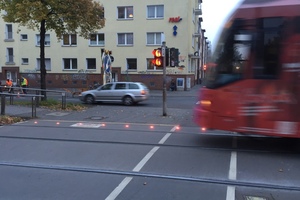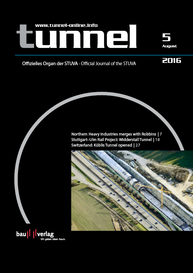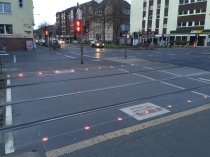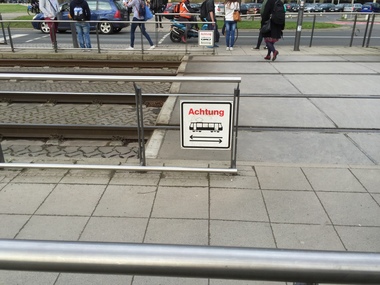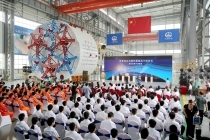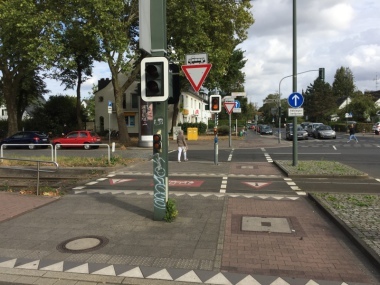STUVA: Ground Caution Lights at Urban Railway Track Crossings in Cologne ineffectual – Inverted Signal Templates show positive Influence on Behaviour of Persons crossing at Red Light
LED Caution Lights at three Railway Crossings
The City of Cologne’s traffic committee had decided in September 2011 to test ground caution lights at railway crossings. The aim was to determine whether traffic safety could be improved as a result. Based on this resolution, in the second half of 2014 LED caution lights were installed for test purposes at three railway crossings for pedestrians and cyclists on the Cologne urban railway network. These lights embedded in the ground are intended as an additional technical safety factor for crossing railways. They are controlled by the same signal image as used for the existing light signal facilities (red/dark).
The STUVA was commissioned by the Cologne Verkehrs-Betriebe AG to carry out an investigation to establish the effectiveness of the ground caution lights. It was supported in its work by the Office for Research, Evaluation and Development (bueffee GbR) from Wuppertal. For this purpose, before and after comparisons were undertaken at two locations (Maarweg and Weißhausstraße). They embraced how the persons using the crossing behaved as well as surveys involving passersby and transport staff. At a third location (Stadtwaldgürtel), it was only possible to question passersby in a subsequent survey. This was due to changes to the technical safety features, which had been carried out parallel to installing the ground caution lights. As a result, any changes in behaviour possibly observed would not have been solely attributable to the ground caution lights.
Observing Behaviour of Passersby
The investigation revealed that the quota of persons crossing on red was relatively high (up to more than 80 % depending on location). Age and sex played a role in this readiness to contravene traffic rules. Younger persons ignored the red light more frequently than older ones. Male pedestrians or cyclists also crossed on red more often than female. The reasons cited most frequently for crossing on red were being in a hurry, the desire to still catch a tram or the inconvenience of having to wait for the lights to change. The observation indicated that the bulk of crossings on red took place, after a tram had passed the crossing point (i.e. behind the tram). For technical reasons the light signals remain switched on for a number of seconds after the urban railway vehicle has passed through – even if no tram is coming from the opposite direction. The surveys showed that in this case the block signal was often not accepted because people failed to believe it was necessary anymore to wait in front of the red signal light.
Ground Caution Lights do not reduce the objective Risk of Accidents
No change in the behaviour of persons crossing at red was observed in the surveys undertaken at the two locations, which were investigated completely. At Maarweg the situation scarcely altered at all from before the survey; at the Weißhausstraße the number of people crossing on red actually increased slightly in the follow-up survey. This location was above all characterized by a “herd instinct”: if a single person decided to go across when the light was red this prompted a whole swarm to follow suit.
In interviews, some people expressed the view that the ground caution lights had made the railway crossing and the displayed red signal easier to identify. Most responses related to a change in personal behaviour in traffic. Thus some persons suggested that now they were more prepared to stop at red. However, the vast majority said that although they had become more observant, they were still prepared to cross the track on red providing they did not feel there was a real reason for waiting. The subjective statements of those asked still to cross at red corresponded with the objective results of observations on the spot in the case of which no drop in the number of those crossing on red could be registered.
Transport staff concluded that if anything the effectiveness of the ground caution lights with respect to reducing people crossing when the lights were at red was slight. However, it was reported that in individual cases an increased degree of attentiveness was to be observed in the case of certain groups, young pedestrians for example.
Applying inverted Signal Templates
In 2015, the City of Cologne decided to try out a study in the case of which the light signal displays at railway crossings were fitted with inverted signal templates. The amount of area showing red increases per light signal owing to the black “pedestrian” signal displayed on a red background. It is hoped that this measure enables the red signal to be more easily recognized and makes pedestrians more aware during block times.
After the effectiveness analysis of the original ground caution lights was concluded, the inverted signal templates were deployed at the Weißhausstraße location that had already been investigated. Subsequently, an additional analysis of the efficacy of the modified ground caution lights was executed on the basis of observations and questioning passersby.
Inverted Signal Templates enhance the Preparedness of Pedestrians to wait
After the signal templates had been replaced the subsequent survey revealed a significantly increased preparedness by pedestrians to wait at red (reduction from 86 % to 58 % of persons crossing on red). This reduction was discernible throughout all age groups and predominated during the morning hours and around midday. Furthermore, a greater number of persons said in the survey that they were now more likely to wait at a red signal.
It must be stated here that the subsequent surveys were only undertaken at a single location so that the results can thus not be further verified with respect to the efficacy of the signal templates respectively the combination of both measures. In addition, the investigation was carried out roughly a month after the templates were replaced. As a result, possible long-term effects (which could be of a weakening nature) could not be pursued.
The effect, however, is estimated as being large. Even after assuming the cited restricting factors, an effect seems likely (albeit one weakened compared to the observation that was undertaken). Owing to a lack of comparative investigations based on observation, however, it could not be clearly shown whether the changes of behaviour were solely attributable to the new signal templates.
No Recommendation for Ground Caution Lights – positive Evaluation of inverted Signal Templates
The investigation on the effectiveness of ground caution lights in Cologne indicated that it is not possible to improve the acceptance of the red light at urban railway crossings by means of this additional technical safety factor. The survey only indicated that the attentiveness of persons who are crossing is increased through the ground caution lights. This was mainly revealed in the form that the persons crossing (in keeping with subjective criteria for estimating danger) sought greater reassurance that they could cross the tracks in spite of the red light. Thus the committing of traffic violations evident to a high degree in some cases in the surveys was not effectively restricted so that the risk of subsequent critical situations arising at the railway crossing could not be properly reduced. This was confirmed by observations of traffic after the ground caution lights had been installed.
The investigation of the efficacy of the inverted signal templates on the other hand actually revealed that this modification of a technical safety factor leads to a change in behaviour at a red light signal. The proportion of those crossing at red at the investigated location, which was previously marked by very low acceptance of the red light, was significantly reduced. The analysis based on observations was, however, only carried out at a single location, where previously the effect of the ground caution lights had been checked.
Based on the available investigation results it was not possible to recommend the deployment of ground caution lights in Cologne as an element designed to cut down on people crossing railway tracks on red. However, the application of inverted signal templates appears to be an effective solution for enhancing traffic safety at urban railway crossings in Cologne, as the number of people crossing at red and thus the danger of critical interactions was substantially diminished at the railway crossings.
Results of Survey included in new Research Project
The results of the investigations are ncluded in a research project “Traffic Safety of Crossing Points for Pedestrians and Cyclists on Tram and Urban Railway Routes” (FE 82.0613/2014). This project was commissioned by the Federal Highway Research Institute (BASt) on behalf of the German Federal Ministry of Transport and digital Infrastructure (BMVI) and is currently being worked on under the aegis of the STUVA. Based on a nationwide analysis of accidents at railway crossings, structural forms adopted in practice as well as constructional and technical safety factors, practical recommendations and proposals are to be produced within the scope of the research project for inclusion on draft codes of standards. This project is scheduled to be completed in autumn 2017.

